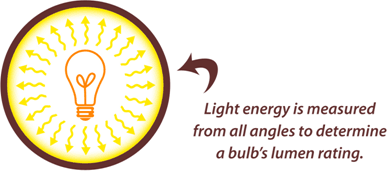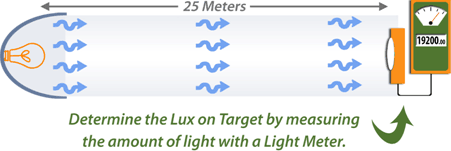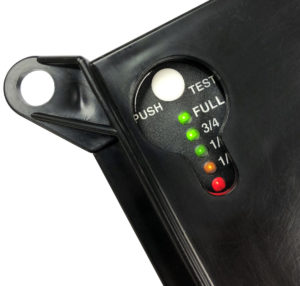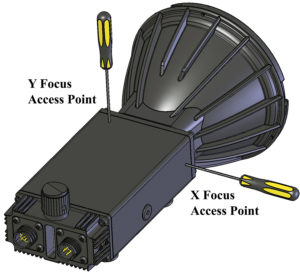OUTPUT AND PERFORMANCE
How bright is the Maxa Beam Searchlight? How is this measured?
The Maxa Beam Searchlight has an output of 12,000,000 CandlePower*. CandlePower measures the intensity of the light that hits a target at a distance, which makes this unit of measure valid for searchlights and other focused light sources that will be used to illuminate specific targets at long ranges.
The measurement and calculation of Candlepower (also called candela) is defined by the ANSI/NEMA FL1: Flashlight Basic Performance Standard.
To determine the Maxa Beam’s CandlePower measurement, the searchlight is focused down to a tight 1° beam and pointed at a target placed at a known distance. A data-logging light meter is used to measure the light intensity illuminating this target. The measured lux value is multiplied by the distance to the target squared to calculate the searchlight’s CandlePower rating.

Peak Beam Quality Technicians test the output of every Maxa Beam Searchlight on a 25 meter range. If requested, Peak Beam can provide a Certificate of Conformance identifying the output of any new Maxa Beam Searchlight at time of shipment.
To view a CandlePower Test Report from an independent, certified laboratory, please visit the downloads page.
*no maximum threshold; 10% minimum threshold.
What is the Maxa Beam’s Range?
Every Maxa Beam Searchlight has the following range when set to high beam and focused to its tightest 1° spot:
- 0.25 lux @ 6,925 meters (4.3 miles) [ANSI/NEMA FL1 Standard Range]
- 1 lux @ 3,500 meters (2.15 miles)
- 12 lux @ 1,000 meters (.62 miles)
The measurement and calculation of Range is defined by the ANSI/NEMA FL1: Flashlight Basic Performance Standard. According to this standard, a flashlight’s range is the calculated distance at which it will provide a light intensity of 0.25 lux on target.
Using the calculations set forth in the ANSI/NEMA FL1 Standard, the Maxa Beam’s range is nearly 7 kilometers!
Practically speaking, however, 0.25 lux is a very small amount of light and factors like moisture or particles in the air and limitations on optics will impact the real-world, practical use of 0.25 lux at 6,925 meters. Peak Beam Systems therefore typically rates the Maxa Beam’s range as the distance at which it will provide the more useable intensity of 1 lux on target.
Why are some high intensity lights measured in Lumens? What’s the difference between Lumens and CandlePower?
 When comparing multiple lighting products, it is useful to understand the terminology that various lighting manufacturers use to describe the output of their products. Depending on the intended application, certain units of measure may be much more relevant than others. For example, if you need a floodlight or close range work light, a product’s Lumen rating will be important for you to consider. If you require a light for long range search and rescue, security, or surveillance applications, a product’s CandlePower rating will be a more relevant measure than its Lumen rating.
When comparing multiple lighting products, it is useful to understand the terminology that various lighting manufacturers use to describe the output of their products. Depending on the intended application, certain units of measure may be much more relevant than others. For example, if you need a floodlight or close range work light, a product’s Lumen rating will be important for you to consider. If you require a light for long range search and rescue, security, or surveillance applications, a product’s CandlePower rating will be a more relevant measure than its Lumen rating.
The lighting industry uses several methods to measure light. There are two units of measurement that are often used to describe high intensity lighting devices: Lumens and CandlePower.
Lumens are a measure of how much light comes from just the bulb itself. Lumens are measured by putting the bare bulb in a device called an Integrating Sphere that can detect the light energy hitting its surface from all directions. Properly measuring lumen output is quite difficult and therefore is not done by many flashlight manufacturers. As a result, flashlight manufacturers almost always list the lamp vendor’s data which is always in Lumens because this is the most appropriate measure for a lamp.
Lumens do not take into account the design of the reflector, optics, or focusability of the beam of light. This is important to note because not all of the bulb’s energy ends up being directed into the beam and onto your target.

Lumens are a useful measurement for floodlights and household light bulbs that will be used to illuminate a wide area directly around the bulb. Lumens become less valid when you need to know how much of a bulb’s energy is actually being collected and directed towards your target. That’s where the second unit of measure, CandlePower, comes in.
CandlePower measures the intensity of the light that hits a target at a distance. CandlePower takes the performance of the whole fixture into consideration, which makes this unit of measure more relevant than Lumen output for searchlights and other focused light sources that will be used to illuminate specific targets at long ranges.

CandlePower is measured using a light meter that detects intensity on target in Lux (SI unit) or Foot-Candles (non-SI unit). The light meter is set at a distance from the light fixture and the beam of light is pointed at the Light Meter’s probe. To calculate CandlePower, multiple the Light Meter’s Lux reading by the Distance (in meters) squared between the light and the meter’s probe. (If using Foot-Candles, multiple this reading by the Distance in feet squared.)

It is not possible to convert Lumens to CandlePower because these units measure different aspects of a light’s output. Depending on what kind of fixture a bulb is placed in, a bulb with a high lumen rating may not necessarily have a high CandlePower rating. For example, you can take two identical bulbs with the same lumen rating, place them into two different fixtures, and get two different CandlePower measurements.

OPERATION AND SAFE USE
What safety precautions should I take when operating the Maxa Beam?
ANSI Risk Group 3. Warning.
Visible and infrared radiation emitted from this searchlight.
Permanent eye damage can result. Avoid direct exposure to the beam.
- Do not look directly into the searchlight beam. Exposure of the eye to either the direct searchlight beam or a beam reflected from a flat mirror-like surface can cause permanent eye injury to the unprotected eye. Follow the same precaution even when an Infrared Filter is installed on the searchlight.
- Nominal Ocular Hazard Distance (NOHD), Visible Light: 10 meters
- NOHD, Infrared Light: 30 meters for exposures greater than 10 seconds
- Do not operate searchlight if the front lens is damaged or removed. Ultraviolet injury to skin and cornea can occur if the searchlight is operated with a damaged front lens or if the lens is removed.
- Do not allow the concentrated beam of light to be focused on flammable materials at close distances for prolonged periods of time.
- Do not operate light in an explosive environment.
- Do not touch lamp connections during operation as high voltage is present.
- Do not touch the quartz envelope of the lamp. If the lamp is accidentally touched, clean with alcohol or the solution supplied in the replacement lamp kit.
- Always wear protective eyewear, long sleeves, and gloves if removing the front lens cover. The lamp is under positive pressure and should be handled with care.
- Always disconnect searchlight from power cord when not in use, when placed in storage or when being transported to prevent accidental activation.
How do I connect the Maxa Beam for operation?
Connecting a handheld Maxa Beam Searchlight to a battery is fast and easy. The searchlight requires no warm up or cool down and the Maxa Beam’s four-way joystick switch gives you instant control of spot, flood, strobe, and high beam.
Check out the video below for basic set up and switch functions of the Maxa Beam Searchlight:
More detailed information is available in the Operation Manual on the downloads page.
What User-Programmable Functions are available on the Maxa Beam?
The Maxa Beam’s beam width limits, beam intensity, strobe rate, strobe duration, beam start-up position, and several other characteristics can be easily programmed by pressing the red and black switches in a specific sequence. This capability allows the searchlight to be customized for specific applications.
For example, if you want to use the light for an extended search operation in a wooded area, the light can be programmed to automatically start up in low beam mode with the beam width at full flood. Other scenarios include a surveillance operation where the light must start up at normal power with the beam set to the size of the area under surveillance or a tactical application where the user programs the light to start up in strobe mode at a narrow beam spread.
To view the default factory settings and all of the optional programming sequences, please consult the Programming section of the Operation Manual, available on the Downloads page.
SPARES AND MAINTENANCE
Are new batteries compatible with older searchlights?
Yes! Peak Beam’s current MBP-1308 Series LiFePO4 Batteries can be used with all older Maxa Beam Searchlights. Just keep in mind that you’ll also need to purchase a LiFePO4-compatible charger and cord to use with the new battery. Your old battery charger and cord will not work with the new battery.*
 MBP-1308 Series Batteries are available in a standard, no-frills housing (MBP-1308) or can be upgraded with a 5-level LED fuel gauge (MBP-1308-FG). The fuel gauge reports the battery’s state of charge and state of health and is located in one of the recessed slots on the top of the battery.
MBP-1308 Series Batteries are available in a standard, no-frills housing (MBP-1308) or can be upgraded with a 5-level LED fuel gauge (MBP-1308-FG). The fuel gauge reports the battery’s state of charge and state of health and is located in one of the recessed slots on the top of the battery.
All LiFePO4 Batteries feature a 115 minute run time, 110 minute charge time, and more than 2,000 life cycles. LiFePO4 Batteries weigh 3.0 lbs. and do not develop a memory, meaning they can be recharged or topped off at any time.
Older, discontinued Maxa Beam Batteries include the MBP-1207 NiCad Battery, MBP-1307 Li-Ion Battery, and MBP-1310 10Ah LiFePO4 Battery. For information on using and charging older batteries, please see the Legacy Battery Systems guide available on the Downloads page.
Caution: Only use Maxa Beam batteries with your searchlight; using third party batteries may damage the searchlight and will void the product warranty.
*The only exception is if you own an old MBP-1310 10Ah LiFePO4 Battery. In this case, your existing charger and power cord WILL be compatible with a new MBP-1308 LiFePO4 Battery.
What maintenance is required for the Maxa Beam Searchlight? What components are user-serviceable?
For best performance, clean the searchlight’s front lens with window cleaner or rubbing alcohol. Periodically wipe down the body of the searchlight with a damp cloth, especially in marine environments where the housing is exposed to salt.
If the searchlight is dropped or receives a heavy impact, it may be necessary to refocus the lamp (see below).
The Maxa Beam’s lamp, lens, and plastic connectors are all user-serviceable parts. Please see the Maintenance section of our online catalog to view available replacement kits.
How do I refocus the Maxa Beam’s Lamp?
If the searchlight is dropped or receives a heavy impact from transportation or shipping, it may be necessary to refocus the lamp to insure proper operation and maximum output. Refocusing the lamp involves centering the lamp in the reflector.
 Use the 1/16” Hex Driver that is included with the Maxa Beam Searchlight to remove the two focus access screws and washers that cover the X and Y Focus Access Points.*
Use the 1/16” Hex Driver that is included with the Maxa Beam Searchlight to remove the two focus access screws and washers that cover the X and Y Focus Access Points.*- Turn the searchlight on and shine the beam onto a flat surface approximately 25 meters away. (In general, ranges from 15 to 100 meters will suffice but at farther distances it will become more difficult to see the precise adjustments taking place as the lamp is focused.)
- Insert the hex driver into one of the focus access points. A slight rotation and/or side to side motion may be required until the hex driver becomes properly seated into the internal adjustment screw hole.
- After the hex driver has been inserted into the adjustment screw, turn the driver slightly to rotate the screw. Notice how the hot spot of the beam moves on the target. Rotate the driver until the hot spot is centered in the beam on this axis.
- Repeat steps 3 and 4 for the other internal adjustment screw in the other focus access point. Continue to switch between the X and Y focus access points until the hot spot is centered on both axes.
- Adjust the searchlight’s beam width out to flood and then back in to spot. If you notice that the light’s focus has changed as you bring the beam back into spot, adjust the focus of the light and then repeat the process of increasing the beam width to flood and decreasing it to spot until the focus remains consistent.
- Replace the focus screws and washers when focusing is complete.
*An MBPKG-E Series Searchlight must first be removed from its enclosure in order to access the X and Y Focus Points. To do so, use a 9/64” Hex Driver to remove the housing screws and washers around the back plate of the searchlight. Grasp searchlight’s handle and pull the searchlight straight out of enclosure tube. Consult the Instruction Sheet included with that MBA-2400-E Lamp Replacement Kit for further details.
How long does the Maxa Beam’s Xenon Lamp last?
The Maxa Beam’s Xenon Short Arc lamp is rated for 1,500 hours. For best performance, we recommend that you replace your lamp after 1,000 hours of use.
Maxa Beam Lamps are field-replaceable. Visit the Maintenance page to view available Lamp Replacement Kits.
SERVICE AND SUPPORT
What is the Maxa Beam Searchlight’s Warranty?
All Maxa Beam Searchlights are warrantied for one year with the exception of the lamp (bulb) and battery which are warrantied for 90 days. Extended warranties may be purchased at time of sale for an additional fee. Please visit the Warranty page for Peak Beam’s full warranty details.
Regardless of warranty status, Peak Beam is committed to providing support for ALL Maxa Beams, even units that are 20+ years old or those that are being resold on eBay (see below).
If you need technical assistance for your Maxa Beam please feel free to give us a call or send us an email and we will be happy to help!
Can I consult with Peak Beam before purchasing a second hand Maxa Beam Searchlight on eBay?
YES! We welcome questions and we are happy to help you make an educated decision before you purchase second hand Maxa Beam equipment on eBay, Craigslist, or any other reseller site. Variations of the Maxa Beam Searchlight have been fielded since 1987, so the age and condition of used searchlights being resold by third parties varies significantly. Before making an online purchases of used Maxa Beam equipment, we strongly recommend that you do the following:
- Ask the seller for the Model Numbers and Serial Numbers for all Searchlight(s), Battery(s), and Charger(s) being offered. Contact Peak Beam with this information and we will tell you the original ship date so you know exactly how old the equipment is.
- Ask the seller to confirm that all elements of the searchlight kit are functioning. Sellers occasionally advertise “new” batteries “still in their original packaging” but this does not guarantee anything about the battery except that it may have been stored for many years without being charged or cycled. Long term storage of batteries can cause permanent damage and those “new” batteries may very well be dead.
Please note that although Peak Beam does not warranty used equipment and cannot guarantee the condition of any equipment you may purchase from a third party, we are still happy to help tune up and repair any older equipment you may acquire. Please contact us to request a Return Authorization and repair estimate.
My Maxa Beam is stuck in strobe mode and won’t turn on to a steady beam. What can I do to troubleshoot?
99% of the time searchlights “stuck in strobe mode” are simply not receiving enough input power to fully turn on. The flashing or strobing that you see is the lamp repeatedly trying (and failing) to start up.
To troubleshoot, start by giving your searchlight a visual check for damage. With the searchlight turned off, look into the front lens. Is the lamp crooked? Has the lamp’s front tip become unseated from the locator at the center of the front lens? If you suspect that the lamp needs to be reseated, consult the Operation Manual for details on how to remove the lens and reinsert the lamp in its socket.
Next, check your power source. Batteries that are nearing end of life are the most common cause of searchlights “stuck in strobe mode.” If possible, test the flashing searchlight with a known, functioning power source to see if this corrects the problem.
- Are you using an older battery? Fully charge the battery before attempting to power up the searchlight again.
- Do you have a 12V vehicle adapter, power supply, or a battery that you know works with another Maxa Beam Searchlight? Try powering up the flashing searchlight with one of these sources to determine if your battery is the problem.
If the searchlight still does not turn on to a steady beam after verifying the power source, this could indicate that the searchlight’s lamp needs to be replaced. Visit the Maintenance page for replacement kit options.
If you have a very old searchlight, constant flashing could also indicate that the searchlight’s circuit board needs to be replaced. Visit the Warranty and Returns page for information on how to request an RMA to return your light for repair.
In all cases, please feel free to contact us for phone or email support. We can walk you through the troubleshooting steps and, if you provide your searchlight and battery serial numbers, we can date your searchlight and make targeted recommendations based on the age of the system.
I hear that some searchlights have a dark spot at the center of the beam. Is there a dark spot obstructing the beam of the Maxa Beam?
The Maxa Beam does not have a dark spot at the center of the beam from a 1° spot to a 15° flood. The tight spot of the beam in this wide range produces brilliant white illumination that is even and diffused. Beware of other illumination products that claim to have the only light completely free of this black hole; other illumination products do not offer more than a 15° beam spread. For applications where the Maxa Beam will be used in flood mode, the optional Collimating Lens eliminates any dark spots in the beam by redirecting excess spill light into the center of the beam.
 Searchlight
Searchlight